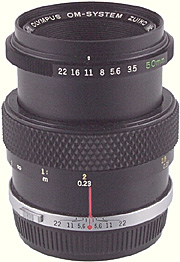Close-up and macro photography for entomologists
Macro lenses

Macro lenses provide the best and most convenient method of taking close-ups, but they are expensive. They differ from ordinary lenses in having an extended focusing mount that can focus from infinity to a magnification of ×0.5 or ×1.0 simply by turning the focusing ring. Their optical performance is optimised for short working distances instead of infinity, and they are often more highly corrected than ordinary lenses. For 35 mm cameras, they come in focal lengths of about 50–60 mm, and in longer lengths between 90 and 105 mm and between 180 and 200 mm; they are also available for roll-film cameras. The longer focal length lenses provide greater working distances, which allows more room for lighting and helps to avoid alarming live subjects. The 50 mm lenses can be used as a standard lens in place of one with a restricted focusing range. If you do not use a TTL meter, exposures must be adjusted as the magnification is increased beyond ×0.1.
Additional extension
If your macro lens incorporates floating elements for better performance at short distances, then you should make sure that the lens is set for close focus (not for infinity focus) if you use it on extension tubes or bellows.
Reverse mounting
You should also set the lens for close focus if you use it with a reversing ring. Reversing the lens exposes the rear element and various coupling mechanisms that are protected when the lens is mounted normally. You can provide them with some protection by adding a short extension tube to act as a makeshift lens hood; an old manual tube will do. You can also buy special adapters that allow a filter or a lens hood to be attached to the rear of a lens.
Focusing
Depth of field is very small at ×0.5 or ×1.0, so to you may find it easier to focus exactly where you want if the auto focus is turned off. You will probably find it easier to focus by moving the camera backwards and forwards after setting the magnification that you want.
Using a precise magnification
Focusing by turning the focusing ring or using autofocus changes the magnification. If you want to use a particular magnification that is engraved on the lens, turn off the autofocus, set the focus ring for the magnification you want, and then focus by moving the camera backwards and forwards until the image in the viewfinder is sharp. If you are using a tripod or a macro stand, then a focusing rail makes it easy to focus this way. Focusing by moving the whole camera also makes it easier to focus at around life-size, where manual focusing can be imprecise because turning the focusing ring causes simultaneous changes in the extension and the working distance that interact in such a way as to have little effect on the focus.
Good points
- Excellent results
- Automatic diaphragm and automatic exposure are normal
- Automatic focusing is available if the camera system supports it
- Can be used instead of a standard or portrait lens
Bad points
- Expensive
- Bigger and heavier than an ordinary lens of the same focal length
- May not have as fast a maximum aperture as an ordinary lens of the same focal length
- Automatic focusing may not focus on exactly the right point
See also: Bellows macro lenses, Olympus macro lenses
Send comments or questions to Alan Wood
![]()
![]()
Created 27th December 1997 — Updated 23rd April 2001
Copyright © 1987–2001 Alan Wood